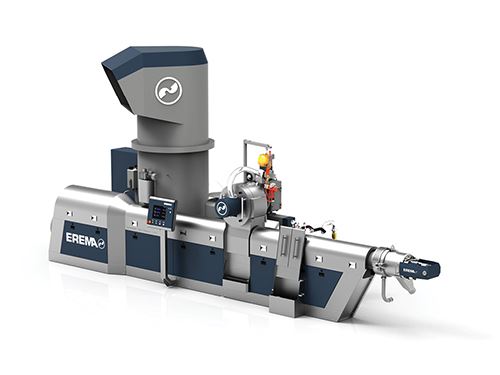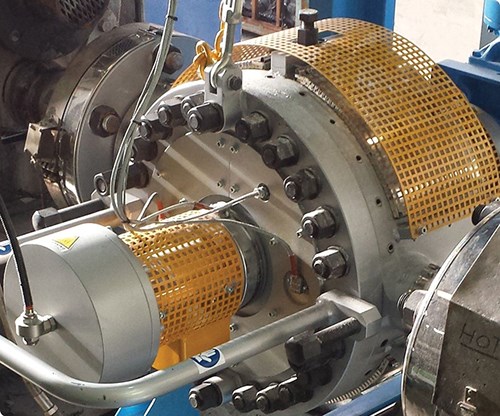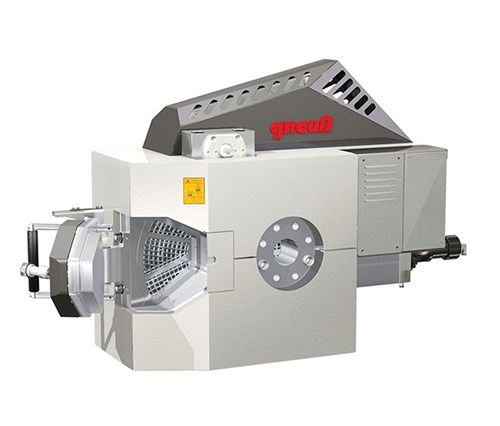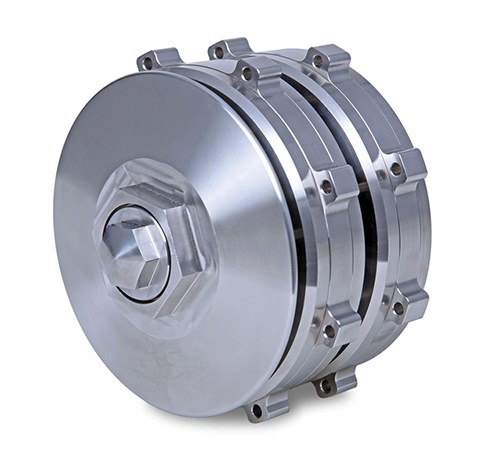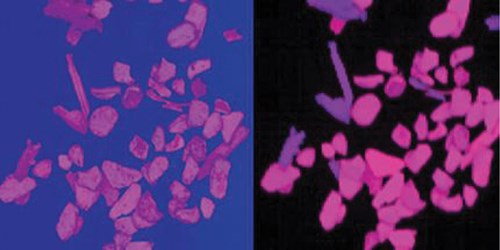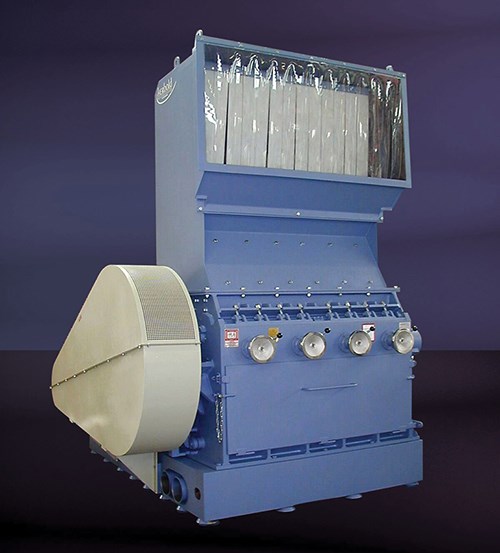RECYCLING/SCRAP RECLAIM AT NPE: Less Waste And Lower Maintenance
Whether for commercial recycling or in-house scrap reclaim, new systems boast reduced maintenance, higher throughput, and less waste of resin for purging.
Recycling and reuse of plastics scrap, as well as the reduction of plastics wastes, is one of top priorities of SPI and its industry partners. This is exemplified at NPE2015 with
the “Zero Waste Zone” sector of the exhibit hall, and the surrounding Recycling and Sustainability Pavilions. Combined, they will provide attendees with concentrated access to companies and technologies dedicated to these goals.
The programs and events planned for the Zero Waste Zone are:
• Recycling demonstrations, including one by Rapid Granulator, which will process PET products into reusable flakes.
• Products made from recycled plastics, displayed by companies such as Dell, EcoStrate, Green Toys, Preserve Products, Seventh Generation, and TerraCycle.
• “Editourmobil” van for analyzing the PET industry of North America on-site, provided by PETplanet Insider magazine.
• “Pursuing Zero Waste” Wall, where NPE attendees can pin their business cards to show their commitment to zero waste (and become eligible to win a motorcycle).
• International Beer Garden, an attendee networking spot, opening at 11 a.m. daily, where special events will be held.
If you’re looking for new recycling/reclaim equipment, expect to see complete systems from at least two companies. Look for at least five companies featuring the latest innovations in filtration systems. There are also new granulators, shredders, grinders, and cleaning systems. The latest in optical sorting by at least two companies will be demonstrated, as will a new pneumatic conveying system for recycling operations.
RECYCLING SYSTEMS
NGR Recycling Machines will introduce P:React, a system based on LSP (Liquid State Polycondensation) that is said to considerably improve the properties of recycled PET—always a goal of PET processors and recyclers. Its continuous operation is said to provide recycled pellets with a narrow IV range, suitable for use in high-end applications such as sheet extrusion or fiber spinning.
NGR systems combine shredding with extrusion and pelletizing in a single step. Automatic filtration systems for highly contaminated waste complement these machines.
The LSP process uses PET’s inherent capability to post-condensation in the melt phase under vacuum, which leads to an increase of intrinsic viscosity (IV). The system’s high vacuum effectively decontaminates the material from harmful chemicals, reportedly
allowing use of the repelletized material for food contact.
As molten PET enters the vertical part of P:React, strands are formed to create a high surface-to-volume ratio to enhance devolatilization. Material is then collected in a horizontal drum and slowly pushed forward. Post-condensation starts immediately as
the strands are formed and continues until PET exits the P:React system. IV increase is controlled by the residence time of the molten PET inside the machine and can be adjusted to a desired level and is maintained within a small tolerance band.
Erema North America will feature an Intarema 1108 TVEplus recycling system. This system reprocesses difficult materials such as heavily printed films or wet scrap by combining filtration, homogenization, and degassing in one step. Moreover, the fact that filtration occurs upstream of degassing is said to improve pellet quality.
Erema will also show its newly enhanced, fully automatic edge-trim system, Intarema 605 K, which is for reprocessing in-house reclaim.
Designed for industrial and post-consumer reclaim, the recoSTAR dynamic line to be displayed by Starlinger is suited for lightweight, wet, and hygroscopic materials. The line includes a “smart” feeding system and a high-efficiency extruder, reportedly resulting in higher outputs while consuming less energy.
DEVELOPMENTS IN FILTRATION
ADG Solutions will debut new control programming on its upgraded Fimic continuous, self-cleaning screen changers/filters. which is said to dramatically reduce the amount of polymer required to purge contaminants filtered from the process stream. ADG will showcase a Fimic model APR 500.
During operation, the melt filtration unit is positioned at the extruder outlet, where it is said to retain contaminants as small as 150 microns. As contamination builds up on the upstream side of the screen, inlet pressure increases to the user’s setpoint, triggering a scraper that removes contamination from the face of the screen filter.
According to ADG, most screen changers of this type would immediately channel some melt to purge the contaminants from the unit through a discharge valve, which can waste resin. But this system can cut the amount of resin wasted in the cleaning process in half or more, ADG says. Fimic units store up to six scrapings—which can occur as often as once an hour in applications involving dirty reclaim—and discharge all the accumulated contamination at once.
Other innovations include new laser-cut screen plates that ensure extremely long life.
With 15% open area, backpressure is minimized, even at such fine filtration levels. A
continuous scraping mode is available to prevent pressure instability by immediately
removing contaminants that can quickly blind the screen.
NGR will introduce to North America its BritAS Automatic Band Melt Filter for handling high volumes of heavily contaminated melt—predominantly PE. This filtration system has been shown to provide effective melt cleaning to a fineness of 70 microns.
Gneuss will also show the latest addition to its range of screen changers for highly contaminated PVC—the SFpvc. This rotary screen changer is characterized by adaptability to exactly match the individual extruder and by its very robust drive system to handle contamination surges.
Gneuss will also display its latest RSFgenius for highly contaminated materials, and the Rotary Filter KR, a discontinuous screen changer. This is a very rugged and compact model that is specially suited for fast color changes.
An improved design of a screen-changer filter cartridge, first launched at K 2013, is said to overcome many of the shortcomings of standard filter discs or candles. Shown by Nordson Kreyenborg, this filter cartridge is said to prevent pressure loss and deformation of the steel filter fabric, due to its robust structure that can withstand high mechanical stresses encountered during production startup. Rheological optimization of the cartridge design reportedly eliminates stagnation zones and allows 100% utilization of the open filter area.
Kreyenborg reports that the filter cartridge has enabled a European operator of a high-throughput Starlinger bottle-to-bottle PET recycling line reduce the frequency of filter
replacement and improve pellet quality.
The Starlinger recoStar PET HC iV+ recycling line at this plant includes a Nordson Kreyenborg K-SWE-4K-75/RS screen changer and is capable of outputs from 3100 to 3500 lb/hr. It converts PET bottle flake to RPET that’s been approved by the European Food Safety Authority (EFSA) for reuse in bottles.
The recycler was able to extend filter life from 8 hr to 72 hr by replacing the standard filter medium with the new filter cartridge. The company also realized a 40% reduction in back-flushing waste, reducing payback time on its investment.
Erema’s Laserfilter is particularly suited for processing materials with a high level of contaminants such as wood, paper, or metal and is said to fulfill requirements not met by conventional melt filters. Its new scraper geometry reportedly offers additional benefits such as longer screen life and reduced labor requirements, thanks to long screen-change intervals.
MAS America will showcase its Continuous Disc Filtration (CDF) system. Available in four sizes, the CDF reportedly can be easily integrated into any extrusion line to continuously remove up to 5% of soft contaminants such as wood, paper, aluminum,
rubber, and unmelted polymers.
Its automatic melt-pressure disc-control system increases disc-rotation speed as well as knife-scraper pressure to keep melt pressure stable, which has been shown to greatly increase extruder capacity. The discharge screw and the rotating disc work independently of each other on the CDF. This allows the CDF and screw to be set at different RPMs, resulting in minimal polymer loss and maximum contaminant discharge.
The CDF knife scrapers are set to a fixed point on the rotating disc, allowing the contaminants on the disc to be removed immediately as they are brought to the knife, not dragged across the filter screen by the knife as in other designs. This stationary knife
design reportedly helps prevent the possibility of “cutting” or disintegration of the contaminant. The knife scraper is made of brass to prevent added wear to screen.
EFFICIENT WASHING SYSTEMS
Lindner washTech GmbH will highlight the recent installation of one of its custom plastics washing systems at Cedar Poly LLC in Tipton, Iowa, a plastic scrap trading and recycling company. The installation reportedly enabled Cedar Poly to significantly boost capacity (from 661 lb/hr up to 5500 lb/hr) and raise its product quality. Cedar Poly uses the new system as part of its recycling line for post-consumer HDPE containers and bottles.
GRANULATORS, SHREDDERS, GRINDERS
Herbold will show its newly redesigned SMS Series granulator that can now cope with the most demanding heavy-duty size-reduction applications in a single step. These machines have rotor widths from 23.5 to 78.75 in. and drive capacities between 60 and 420 hp. Segmented knife design ensures a quick and easy exchange of the cutting tools.
The granulators have a third bed knife called a “deflection wedge.” When it is
removed, larger, bulky items can be easily accommodated. Typical applications for
these granulators are thick-walled, semi-finished products, thick-wall pipe, and large purgings.
Vecoplan will debut its latest innovation in size reduction: the V-ECO series of shredders with VFD inverter drives that eliminate gearboxes and fluid couplings, sense tramp metal and stop automatically, and match rotor speeds and torque to load volume and material tenacity (see February Keeping Up ).
As previously reported (see February Keeping Up), other debuts at NPE will be a shredder for hard plastic scrap from Weima America; and a compact dust and fines removal system from Size Reduction Specialists.
Additionally, Tria America will showcase a series of “quiet” grinders for in-line thermoforming scrap recovery; and Zimmer America Recycling Solutions will highlight STF Group’s wet grinder that can dissolve around 95% of paper labels during
shredding (see February Keeping Up).
Foremost Machine Builders Inc. will display its Model QG-1814 Futura Series Plastic
Scrap Grinder. The machine features a contra-skewed mounted-knife arrangement that’s available in either two-bladed hook or three-bladed high-shear rotor options.
The right-angle cutting chamber incorporates an offset rotor allowing the unit to accept large bulky parts while minimizing flyback. The unit is also equipped with integral sound absorption cabinetry and a double-walled hopper for quieter grinding.
At NPE, the unit will be displayed with an air-relief elbow on top of the hand-fed hopper. Foremost notes that this particular package is suited to reclaiming blow molded containers.
Cumberland’s Combi inline shredder and granulator system is available in a wide variety of sizes and configurations, the Combi Shredder comes with two or four shafts and sharp-corner disks or “hooks” that drive the material towards the cutters for a cleaner cut.
Bigger pieces can be added again for further shredding, with final sizes measuring 4-8 mm. The Combi Shredder is recommended for shredding a variety of plastics, including clamshell packaging, film, and PET bottles.
OPTICAL SORTERS
Described as the “pinnacle of sorting performance” is a series of optical sorters from Buhler for PET, HDPE, rigid PVC, PP, ABS, PS, and waste electrical/electronic equipment and end-of-life vehicle residue. The new Sortex A range boasts increased quality of recycled and virgin plastics, the highest capacity in the market, consistent performance, and lower operational costs.
Sortex A inspection systems use broadband LED lighting and special high-resolution cameras in order to target objects within the entire visible spectrum. Buhler’s enhanced
InGaAs technology can detect defects that cannot be seen in the visible spectrum, providing much better separation of good product from foreign material of the same color.
S+S Separation and Sorting Technology (sesotec.com), which at the end of this month will change its name to Sesotec, is featuring its upgraded Varisort Compact N multisorting vision system for recycling. It will be displayed with three sensors for polymer identification, color identification, and metal detection.
It boasts high throughput rates, “teachable” evaluation, and easy operation. Material to be inspected is fed by specifically adapted vibration chutes that are said to guarantee a homogeneous distribution over the full width of the conveyor belt.
At the end of the belt, the material is classified with the corresponding sensors. Following evaluation of sensor information, high-speed valves are actuated with a corresponding time delay to blow out the material. Precisely targeted compressed-air blasts are used to deflect the particles to be separated from their original fall parabola into a separate duct.
PNEUMATIC CONVEYING FOR RECYCLING
Air Trim, Inc. will feature its newest pneumatic conveying systems targeted to recycling facilities as an environmentally friendly alternative to open conveyors. Pneumatic transfer of materials from the collection area either to staging in the baler area or directly onto the baler’s conveyor belt eliminates the use of vehicles, carts, drays, and other devices to transport plastics.
A Jumbo Venturi design is said to maintain sufficient airflow from intake to receiver, providing high throughput for bulky, heavy, and odd-sized waste products such as gallon milk jugs, large detergent bottles, and other cumbersome materials. Direct conveying by this induction system is said to reduce sorting time and labor costs.
Related Content
Foam-Core Multilayer Blow Molding: How It’s Done
Learn here how to take advantage of new lightweighting and recycle utilization opportunities in consumer packaging, thanks to a collaboration of leaders in microcellular foaming and multilayer head design.
Read MoreResins & Additives for Sustainability in Vehicles, Electronics, Packaging & Medical
Material suppliers have been stepping up with resins and additives for the ‘circular economy,’ ranging from mechanically or chemically recycled to biobased content.
Read MoreAdvanced Recycling: Beyond Pyrolysis
Consumer-product brand owners increasingly see advanced chemical recycling as a necessary complement to mechanical recycling if they are to meet ambitious goals for a circular economy in the next decade. Dozens of technology providers are developing new technologies to overcome the limitations of existing pyrolysis methods and to commercialize various alternative approaches to chemical recycling of plastics.
Read MoreRecycling: What's Ahead in Advanced Sorting Technology
As the industry tries to ramp up recycling, there are several innovative sorting solutions in the offing—ranging from enhanced optical sorting technologies and chemical tracers to advanced solutions based digital watermarks and artificial intelligence.
Read MoreRead Next
Why (and What) You Need to Dry
Other than polyolefins, almost every other polymer exhibits some level of polarity and therefore can absorb a certain amount of moisture from the atmosphere. Here’s a look at some of these materials, and what needs to be done to dry them.
Read MoreAdvanced Recycling: Beyond Pyrolysis
Consumer-product brand owners increasingly see advanced chemical recycling as a necessary complement to mechanical recycling if they are to meet ambitious goals for a circular economy in the next decade. Dozens of technology providers are developing new technologies to overcome the limitations of existing pyrolysis methods and to commercialize various alternative approaches to chemical recycling of plastics.
Read MoreHow Polymer Melts in Single-Screw Extruders
Understanding how polymer melts in a single-screw extruder could help you optimize your screw design to eliminate defect-causing solid polymer fragments.
Read More
